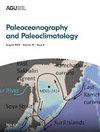通过无监督聚类方法揭示北太平洋西部Pelagic粘土的高维化学地层学
IF 3.2
2区 地球科学
Q2 GEOSCIENCES, MULTIDISCIPLINARY
引用次数: 0
摘要
Pelagic粘土构成了块状且明显均匀的岩性,这限制了相邻沉积物岩芯样本之间的地层对比。最近对北太平洋西部远洋粘土的研究表明,沉积物的整体化学成分构成了多元化学地层学,推断了几个岩芯中明显无特征的远洋粘土层之间的相关性。然而,这种启发式方法只使用了少数元素。因此,本研究采用多元统计技术,包括k均值聚类分析,对北太平洋西部远洋粘土1646个样本×41个元素的化学成分数据集进行了分析。远洋粘土按特定顺序从海底到深度系统排列,分为10组,构成反映这41种元素高维地球化学特征的地层单元。这一发现有力地支持了北太平洋西部远洋粘土潜在化学地层学的统计稳健性。此外,我们对代表每个星团的质心样品的碎屑硅酸盐部分进行了Sr–Nd–Pb同位素分析。碎屑部分的多同位素特征各不相同,从北美和亚洲尘埃的混合物到火山输入叠加的亚洲尘埃的优势。基质成分的这种长期变化可归因于太平洋板块的西北运动和整个沉积史上弧形火山活动的时变影响。所提出的多元统计和同位素分析的综合方法有效地提取了隐藏在远洋粘土中的基本信息,这可能为针对远洋领域的古海洋重建提供一种新的方案。本文章由计算机程序翻译,如有差异,请以英文原文为准。
High‐Dimensional Chemostratigraphy of Pelagic Clay in the Western North Pacific Ocean Revealed via an Unsupervised Clustering Approach
Pelagic clay constitutes massive and apparently uniform lithology that limits the stratigraphic correlation between neighboring sediment core samples. Recent studies on the pelagic clay in the western North Pacific Ocean demonstrated that the bulk chemical composition of sediments constitutes multielemental chemostratigraphy, deducing the correlation between visibly featureless pelagic clay layers across several cores. However, this heuristic approach utilized only a few elements. Therefore, this study employed multivariate statistical techniques, including k‐means cluster analysis, to analyze the chemical composition data set of 1,646 samples × 41 elements of the western North Pacific pelagic clay. The pelagic clay was classified into 10 clusters systematically aligned from the seafloor to the depth in a specific order, constituting stratigraphic units that reflected the high‐dimensional geochemical features of these 41 elements. This finding strongly supports the statistical robustness of the latent chemostratigraphy in the western North Pacific pelagic clay. Additionally, we performed Sr–Nd–Pb isotope analyses of the detrital silicate fractions of the centroid samples representing each cluster. The multi‐isotopic features of the detrital fraction varied from a mixture of North American and Asian dusts to a predominance of Asian dust superimposed by volcanic inputs. This secular variation in the matrix components is attributable to the northwestward motion of the Pacific Plate and the time‐varying influence of arc volcanism throughout sedimentary history. The proposed integrated approach of multivariate statistical and isotopic analyses effectively extracted the essential information hidden in the pelagic clay, which may postulate a new protocol for paleoceanographic reconstructions targeting the pelagic realm.
求助全文
通过发布文献求助,成功后即可免费获取论文全文。
去求助
来源期刊

Paleoceanography and Paleoclimatology
Earth and Planetary Sciences-Atmospheric Science
CiteScore
6.20
自引率
11.40%
发文量
107
期刊介绍:
Paleoceanography and Paleoclimatology (PALO) publishes papers dealing with records of past environments, biota and climate. Understanding of the Earth system as it was in the past requires the employment of a wide range of approaches including marine and lacustrine sedimentology and speleothems; ice sheet formation and flow; stable isotope, trace element, and organic geochemistry; paleontology and molecular paleontology; evolutionary processes; mineralization in organisms; understanding tree-ring formation; seismic stratigraphy; physical, chemical, and biological oceanography; geochemical, climate and earth system modeling, and many others. The scope of this journal is regional to global, rather than local, and includes studies of any geologic age (Precambrian to Quaternary, including modern analogs). Within this framework, papers on the following topics are to be included: chronology, stratigraphy (where relevant to correlation of paleoceanographic events), paleoreconstructions, paleoceanographic modeling, paleocirculation (deep, intermediate, and shallow), paleoclimatology (e.g., paleowinds and cryosphere history), global sediment and geochemical cycles, anoxia, sea level changes and effects, relations between biotic evolution and paleoceanography, biotic crises, paleobiology (e.g., ecology of “microfossils” used in paleoceanography), techniques and approaches in paleoceanographic inferences, and modern paleoceanographic analogs, and quantitative and integrative analysis of coupled ocean-atmosphere-biosphere processes. Paleoceanographic and Paleoclimate studies enable us to use the past in order to gain information on possible future climatic and biotic developments: the past is the key to the future, just as much and maybe more than the present is the key to the past.
 求助内容:
求助内容: 应助结果提醒方式:
应助结果提醒方式:


